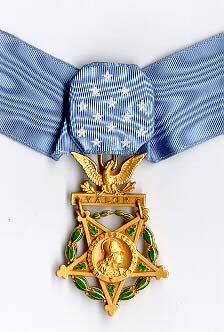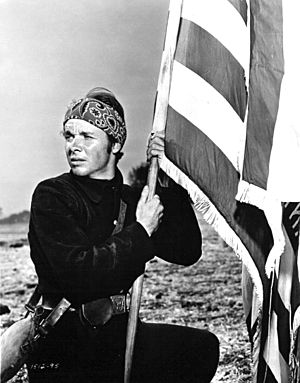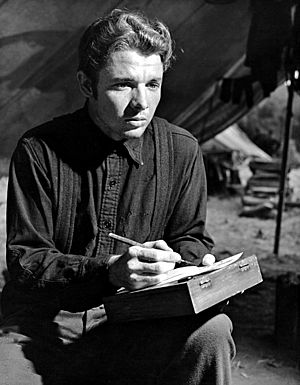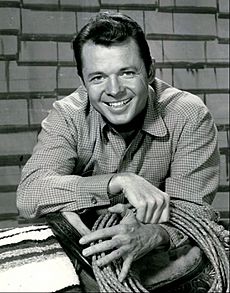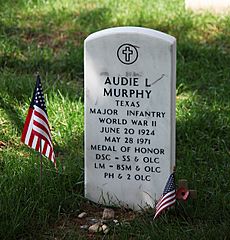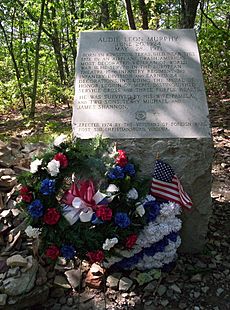Audie Murphy facts for kids
Quick facts for kids
Audie Murphy
|
|
|---|---|
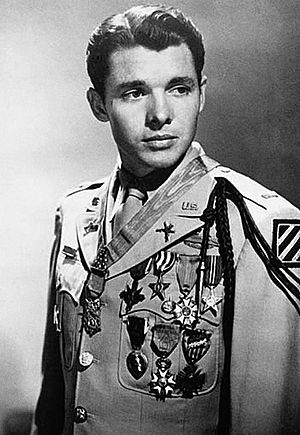
Murphy wearing the U.S. Army khaki "Class A" (tropical service) uniform with full-size medals, 1948
|
|
| Born | 20 June 1925 Kingston, Texas, U.S. |
| Died | 28 May 1971 (aged 45) 14 nautical miles northwest of Roanoke, Virginia, U.S. |
| Buried | |
| Allegiance | United States |
| Service/ |
|
| Years of service |
|
| Rank |
|
| Service number |
|
| Unit |
|
| Battles/wars |
|
| Awards |
|
| Other work | Actor, songwriter, rancher |
| Signature |  |
Audie Leon Murphy (born June 20, 1925 – died May 28, 1971) was an American soldier, actor, and songwriter. He became one of the most celebrated American combat soldiers of World War II. He earned every military award for bravery that the United States Army offered. He also received awards for heroism from France and Belgium.
Murphy was awarded the Medal of Honor for his incredible bravery at age 19. In January 1945, he single-handedly held off a company of German soldiers for an hour in France. He did this while wounded and almost out of ammunition. Then, he led a successful counterattack.
Audie Murphy was born into a large family of sharecroppers in Hunt County, Texas. His father left the family, and his mother died when he was a teenager. Murphy left school in fifth grade to work and help his family. He was very skilled with a hunting rifle, which helped feed his family.
After the attack on Pearl Harbor in 1941, Murphy wanted to join the military. His older sister helped him change his birthdate on official papers so he would seem old enough. The Army, Navy, and Marine Corps first turned him down for being too light. But he eventually joined the Army. He first saw action in 1943 during the Allied invasion of Sicily. Later, he fought in the Battle of Anzio, helped free Rome, and took part in the invasion of southern France.
After the war, Murphy became a successful actor for 21 years. He played himself in the 1955 movie To Hell and Back, which was based on his 1949 book. Most of his other movie roles were in westerns. He also appeared on TV shows and starred in the series Whispering Smith. Murphy was also a talented songwriter. He raised quarter horses and often participated in horse races.
After his military service, Murphy struggled with the emotional effects of war, which is now known as post-traumatic stress disorder (PTSD). He died in a plane crash in Virginia in 1971, just before his 46th birthday. He was buried with military honors at Arlington National Cemetery. His grave is one of the most visited there.
Contents
Audie Murphy's Early Life
Audie Murphy was born on June 20, 1925, in Kingston, a small town in northeastern Texas. He was the seventh of twelve children born to Emmett and Josie Murphy. His family were sharecroppers, meaning they farmed land owned by others and shared the crops. His family had English, Irish, Scottish, and German roots.
As a child, Murphy was often by himself and had strong mood changes. He grew up around the towns of Farmersville, Greenville, and Celeste. His father often left the family and eventually deserted them. Murphy left school in the fifth grade to pick cotton for money to help his family. He also became very good with a rifle, hunting small animals to feed them.
After his mother died in 1941, he worked at a radio repair shop and a general store. Authorities placed his three youngest siblings in a children's home. After the war, Audie bought a house for his oldest sister and her husband. The loss of his mother deeply affected Murphy throughout his life.
Audie Murphy's World War II Service
Audie Murphy always dreamed of being a soldier. After the Japanese attack on Pearl Harbor in December 1941, he tried to join the military. However, the Army, Navy, and Marine Corps all turned him down because he was too young and too light. His sister helped him by providing a false birth date. This made him seem a year older.
He was finally accepted by the U.S. Army on June 30, 1942. After basic training, he was sent for advanced infantry training. During his training, he earned badges for being a skilled marksman with a rifle and an expert with a bayonet.
Fighting in the Mediterranean
Murphy was sent to Casablanca in French Morocco in February 1943. He joined Company B, 1st Battalion, 15th Infantry Regiment, 3rd Infantry Division. After the surrender of Axis forces in Tunisia, his division guarded prisoners. He trained for the Allied invasion of Sicily and was promoted to private first class and then corporal.
When the 3rd Infantry landed in Licata, Sicily, on July 10, Murphy was a messenger. On one patrol, he killed two Italian officers. He got sick for a week but rejoined his company in Palermo. They were assigned to protect a machine-gun position while the rest of the division fought towards Messina.
Murphy also took part in the September 1943 landing in Salerno, Italy. He was promoted to sergeant in December.
In January 1944, Murphy became a staff sergeant. He was hospitalized with malaria and missed the start of the Battle of Anzio. He returned and fought in the Battle of Cisterna. After this battle, he became a platoon sergeant in Company B.
While at Anzio, Murphy and his platoon found shelter in a farmhouse. They killed the crew of a German tank that passed by. Murphy then bravely crawled out alone and destroyed the tank with rifle grenades. For this, he received the Bronze Star Medal with a "V" device for valor.
He continued to go on scouting patrols to capture German prisoners. He was hospitalized again for malaria. In May, Murphy and 60 other soldiers received the Combat Infantryman Badge. He also received a Bronze Oak Leaf Cluster for his Bronze Star. American forces freed Rome on June 4, and Murphy stayed there with his platoon.
Fighting in Europe
During the Allied invasion of southern France on August 15, 1944, Murphy earned the Distinguished Service Cross. His platoon was attacked by German soldiers. He grabbed a machine gun and fired back, killing two Germans and wounding one. Two Germans came out of a house as if to surrender, but they shot and killed Murphy's best friend. Murphy then bravely advanced alone on the house under fire. He killed six Germans, wounded two, and captured 11.
Murphy was with the 1st Battalion, 15th Infantry Regiment, during the August 27–28 fight at Montélimar. This battle secured the area from the Germans. He and the other soldiers who fought there received the Presidential Unit Citation.
Murphy received his first Purple Heart for a heel wound from a mortar shell on September 15, 1944, in France. He earned his first Silver Star after killing four and wounding three at a German machine gun position on October 2. Three days later, Murphy crawled alone towards the Germans, carrying a radio. He directed his men for an hour while the Germans fired directly at him. When his men finally took the hill, 15 Germans were dead and 35 wounded. Murphy's actions earned him a Bronze Oak Leaf Cluster for his Silver Star.
He was promoted to second lieutenant on October 14, becoming a platoon leader. On October 26, Murphy's platoon was attacked by German snipers. He captured two snipers before being shot in the hip by another. He shot that sniper between the eyes. He was hospitalized, and the wound caused partial muscle loss in his hip. He received his first Bronze Oak Leaf Cluster for his Purple Heart for this injury.
The Colmar Pocket was an area in the Vosges Mountains held by German troops since November 1944. On January 14, 1945, Murphy rejoined his platoon in the Colmar area. On January 24, they moved to Holtzwihr, where they faced a strong German counterattack. He was wounded in both legs, earning him a second Bronze Oak Leaf Cluster for his Purple Heart. On January 26, he became commander of Company B.
A German shell hit an M10 tank destroyer, setting it on fire. Murphy ordered his men to retreat to the woods. He stayed alone at his post, firing his rifle and directing artillery fire with his radio. The Germans fired directly at him. Murphy then climbed onto the burning tank destroyer and began firing its machine gun at the advancing Germans. He killed a squad crawling towards him. For an hour, Murphy stood on the flaming tank destroyer, fighting off German soldiers and tanks. He killed or wounded 50 Germans. He was wounded in the leg during this stand and stopped only when he ran out of ammunition. Murphy then rejoined his men, ignoring his own injury, and led them to push back the Germans. He insisted on staying with his men while his wounds were treated.
For his actions that day, he was awarded the Medal of Honor. His division also received the Presidential Unit Citation for their actions at the Colmar Pocket.
On February 16, Murphy was promoted to first lieutenant. He also received the Legion of Merit for his service. He was moved from the front lines to Regimental Headquarters as a liaison officer.
Military Awards and Honors
The United States honored Murphy with many awards for his service in World War II. These included the American Campaign Medal, the European–African–Middle Eastern Campaign Medal with an arrowhead device and 9 campaign stars, the World War II Victory Medal, and the Army of Occupation Medal with a Germany Clasp.
France recognized his service with the Legion of Honour – Grade of Chevalier, the French Croix de guerre with Silver Star, and the French Croix de guerre with Palm. He also received the French Liberation Medal and the French Fourragère. Belgium awarded Murphy the Belgian Croix de guerre with 1940 Palm.
Near Salzburg, Austria, on June 2, 1945, Lieutenant General A.M. Patch presented Murphy with the Medal of Honor and Legion of Merit. When asked after the war why he had taken on an entire company of German infantry, he simply said, "They were killing my friends."
Audie Murphy received every U.S. military award for bravery available from the U.S. Army for his World War II service.
After the War: Military Service
After returning to the United States, there was talk of Murphy attending West Point. However, he never enrolled. He may have decided against it when he realized how much schoolwork was needed to pass the entrance exam.
Murphy was one of several soldiers ordered to Fort Sam Houston in San Antonio, Texas, in June 1945. He was sent home for 30 days to recover. During this time, Murphy was celebrated with parades, banquets, and speeches. He received a Good Conduct Medal in August.
He was discharged from the Army as a first lieutenant in September. He was then transferred to the Officers' Reserve Corps.
Dealing with Post-Traumatic Stress
After his military service, Murphy struggled with posttraumatic stress disorder (PTSD). He had trouble sleeping and experienced periods of sadness. His medical records showed he took sleeping pills to help with nightmares about the war. The stress made his natural moodiness worse, and sometimes he had alarming outbursts.
Murphy spoke openly about his own struggles with PTSD to help other veterans. During his lifetime, this condition was called "battle fatigue" or "shell shock." He asked the government to study the emotional effects of combat more and to give better healthcare to war veterans. Because of his efforts, the Audie L. Murphy Memorial VA Hospital in San Antonio was named after him in 1973.
Texas Army National Guard Service
After World War II, the 36th Infantry Division became part of the Texas Army National Guard. Murphy's friends, Major General H. Miller Ainsworth and Brigadier General Carl L. Phinney, were leaders in the 36th. When the Korean War began in June 1950, Murphy started a second military career. He became a captain in the 36th Infantry Division of the Texas Army National Guard.
He trained new recruits in summer camps and allowed the Guard to use his name and image for recruiting. Although he wanted to join the fighting in Korea, the 36th Infantry Division was never sent there.
Murphy transferred to inactive status in October 1951 due to his film work. He returned to active status in 1955. He was promoted to major by the Texas Army National Guard in 1956 and returned to inactive status in 1957. In 1969, he officially left the Guard and transferred to the United States Army Reserve. He stayed with the USAR until he retired later that year.
Audie Murphy's Film Career
Audie Murphy had an acting career that lasted from 1948 to 1969. During this time, he made over 40 movies and one television series. Actor and producer James Cagney saw a Life magazine article in 1945 that called Murphy the "most decorated soldier." Cagney brought him to Hollywood. Cagney and his brother signed Murphy to a contract and gave him acting, voice, and dance lessons. However, they never cast him in a movie, and their partnership ended in 1947. Murphy later worked with acting coaches to improve his skills.
Murphy lived in a Hollywood athletic club until 1948. A writer named David "Spec" McClure became friends with Murphy. They worked together on Murphy's 1949 book To Hell and Back. McClure helped Murphy get a small role in the 1948 movie Texas, Brooklyn & Heaven. Murphy's agent also helped him get a small part in the film Beyond Glory that same year. His 1949 movie Bad Boy gave him his first main role. The movie's investors insisted that Murphy play the lead.
Universal Studios signed Murphy to a seven-year contract. His first film for them was playing Billy the Kid in The Kid from Texas in 1950. That year, he also made Sierra and Kansas Raiders, where he played the outlaw Jesse James. Universal lent him to MGM in 1951 to star in The Red Badge of Courage, directed by John Huston. Murphy and Huston worked together again in the 1960 film The Unforgiven.
In 1952, Murphy made The Duel at Silver Creek. He worked with director Don Siegel again in 1958 for The Gun Runners. In 1953, he starred in Column South and Tumbleweed. Director Nathan Juran also directed Murphy in Gunsmoke and Drums Across the River. George Marshall directed Murphy in the 1954 film Destry.
Murphy was at first unsure about playing himself in To Hell and Back, the 1955 movie based on his book. But he agreed, and it became the biggest hit for Universal Studios at the time. To promote the film, he appeared on TV shows like What's My Line? and Toast of the Town. Murphy and director Jesse Hibbs worked well together. They made five more films, including Walk the Proud Land, Joe Butterfly, and World in My Corner. Their last film together was Ride a Crooked Trail in 1958.
Joseph L. Mankiewicz hired Murphy to play the main role in the 1958 film The Quiet American. Murphy also formed a partnership with Harry Joe Brown to make three films, starting with The Guns of Fort Petticoat (1957).
In 1957, Murphy was cast in the western Night Passage with James Stewart.
Murphy appeared in three westerns in 1959. He starred with Sandra Dee in The Wild and the Innocent. He also helped produce Cast a Long Shadow and acted in No Name on the Bullet, which critics liked. In 1960, he co-starred with Thelma Ritter in a TV episode called "The Man." In the early 1960s, Murphy helped the United States Army by appearing in three episodes of The Big Picture TV series. He received the 1960 Outstanding Civilian Service Medal for his help.
Writer Clair Huffaker wrote the screenplays for Murphy's 1961 films Seven Ways from Sundown and Posse from Hell. Willard W. Willingham and his wife Mary Willingham were friends with Murphy and worked with him on many projects.
Willard was a producer on Murphy's 1961 TV series Whispering Smith. He also co-wrote the screenplay for Battle at Bloody Beach that year. He worked on Bullet for a Badman in 1964 and Arizona Raiders in 1965. The Willinghams wrote the screenplay for Gunpoint and the script for Murphy's last starring role in the western 40 Guns to Apache Pass in 1967. Murphy made Trunk to Cairo in Israel in 1966.
He first met director Budd Boetticher at an athletic club. Murphy later appeared in Boetticher's 1951 western The Cimarron Kid. Boetticher wrote the script in 1969 for Murphy's last film, A Time for Dying.
Audie Murphy's Personal Life
Murphy married actress Wanda Hendrix in 1949, but they divorced two years later. Four days after his divorce, he married Pamela Opal Lee Archer, a former airline stewardess. They had two sons, Terry Michael (born 1952) and James Shannon (born 1954).
Murphy raised quarter horses at his ranches in California and Arizona. His horses raced at the Del Mar Racetrack. He invested a lot of money in this hobby. Murphy faced financial difficulties later in life. Despite his money problems, Murphy refused to appear in commercials for alcohol and cigarettes. He was aware of his influence on young people.
Death and Memorials
On May 28, 1971, Audie Murphy died in a plane crash. The private plane he was on crashed into the side of a mountain in Virginia. It was raining, cloudy, and foggy, with very poor visibility. The pilot and four other passengers also died.
The aircraft was a twin-engine plane flown by a pilot with a private license. The plane was found on May 31. After her husband's death, Pamela Murphy moved into a small apartment. She worked as a clerk at a Veterans Administration Hospital for 35 years.
On June 7, 1971, Murphy was buried with military honors at Arlington National Cemetery. Many important people attended, including Ambassador to the U.N. George H. W. Bush and Army Chief of Staff William Westmoreland. Murphy's grave is in Section 46. A special walkway was built because so many people visit his grave. It is the cemetery's second most-visited gravesite, after President John F. Kennedy's.
The headstones of Medal of Honor recipients at Arlington National Cemetery are usually decorated in gold. However, Murphy had asked that his stone remain plain, like that of an ordinary soldier. His headstone shows his birth year as 1924, based on military records that may have been changed.
In 1974, a large granite marker was placed near the crash site in the Appalachian Trail. In 1975, a court awarded Murphy's widow, Pamela, and their two children $2.5 million in damages because of the accident.
Audie Murphy received many civilian honors during his life and after his death. These include a star on the Hollywood Walk of Fame. In 2013, his home state of Texas honored him with the Texas Legislative Medal of Honor.
Audie Murphy's Songwriting
David McClure, who worked with Murphy on his book To Hell and Back, discovered Murphy's talent for poetry. He found poems Murphy had discarded in his Hollywood apartment. One of these poems, "The Crosses Grow on Anzio," appeared in To Hell and Back. Only two others survived: "Alone and Far Removed" and "Freedom Flies in Your Heart Like an Eagle." The latter was part of a speech Murphy wrote and was later set to music.
Murphy enjoyed country music but was not a singer or musician himself. Through his friend Guy Mitchell, Murphy met songwriter Scott Turner in 1961. They worked together on many songs between 1962 and 1970. Their most famous songs were "Shutters and Boards" and "When the Wind Blows in Chicago."
See also
 In Spanish: Audie Murphy para niños
In Spanish: Audie Murphy para niños



